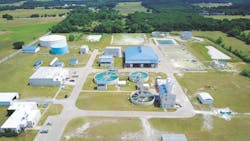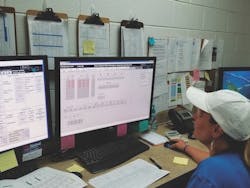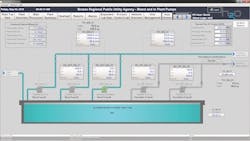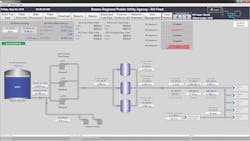About the author:
Jim Meyers is success manager for Inductive Automation. Meyers can be reached at [email protected].
When the Brazos Regional Public Utility Agency in Texas wanted to improve and expand its systems for supervisory control and data acquisition (SCADA) and human-machine interface (HMI), it could have stuck with its familiar vendor. But switching to a different software package is paying off for the agency, which is based in Granbury, Texas, about 70 miles west of Dallas.
In 2016, the agency wanted to upgrade its SCADA system, but the cost of adding more tags would have been prohibitive. So the agency chose to replace the old system with Ignition by Inductive Automation. Ignition is an industrial application platform with tools for building solutions in SCADA, HMI, and the Industrial Internet of Things (IIoT). Agency managers said the new software, the agency gets better control of its systems, improved reporting capabilities, greater data integrity, simplified training and lower costs.
“It’s probably the best move we’ve made so far,” said Alain Richard, operations manager for the agency. “It’s going to give us more flexibility, as far as our operations are concerned. It’s going to make it a lot easier for monitoring, and for our training.”
Ignition uses an unlimited licensing model, enabling industrial organizations to expand their systems with no additional costs for adding tags, devices, clients or projects. With the new software, the agency went from 30,000 tags to 55,000, and has the ability to add many more without additional cost.
“The main thing was the unlimited number of tags,” Richard said. “As we move forward, we’re looking at automating a lot of our systems, so we need a lot of room for more tags. The price from [the previous provider] was way out there; it was a lot of money.”
The change to Ignition is part of a larger effort by the agency to automate more processes and leverage technology to improve efficiency.
Expansion Mode
The Brazos Regional Public Utility Agency was created in 2012 to achieve economies of scale in providing water systems to the public through ownership and operation of a water treatment plant and related facilities. It is a joint venture between Acton Municipal Utility District and Johnson County Special Utility District. The two districts serve 22,000 customers and provide wholesale water to other municipalities.
The agency has one water treatment facility with a production capacity of 13.5 million gal per day. The plant consists of a traditional filtered water operation and an ultrafiltration (UF) and reverse osmosis (RO) operation. It was built in the late 1980s, and receives raw water through one intake located on Lake Granbury, which is fed by the Brazos River.
In choosing and implementing the new software, the agency was assisted by H2O Innovation, a system integrator with headquarters in Quebec City. H2O Innovation designs and provides state-of-the-art, custom-built water treatment solutions based on membrane filtration technology.
H2O was awarded the project in August 2016, with a planned timeline of 12 to 16 months. But the project was expanded along the way to include the agency’s RO and UF systems.
“The agency liked what they saw in our preliminary screens,” said Paul Bartlett, manager of automation and controls engineering for H2O Innovation. “They saw value in what we were doing, and they knew there weren’t any limitations or costs beyond the initial cost of the software.”
That made it easy to expand the scope of the project. The agency began using parts of the system in the summer of 2017, and all facets were installed by the end of May 2018.
With unlimited tags, the Brazos Regional Public Utility Agency in Texas increased from 30,000 tags to 55,000 to better track its systems.
Faster Reporting
The agency had clear objectives for the upgrade. “I wanted to centralize everything,” Richard said. “I wanted the operators to only have to deal with one system. And when H2O told us we could have that and also have all our reports, including our state agency reports, done in that system, that was a big deal to us.”
The new system also gave a greater level of control. “I wanted to have access to all the controls,” Richard said. “For everything at the plant, I wanted us to be able to log into the system and be able to control it. That’s something we didn’t have before. The other system was mostly a view screen, and you couldn’t control everything. None of my ultrafiltration could be controlled. But now with Ignition, I can control everything.”
A much smoother, faster process for reporting has been a key benefit with the new software. This includes critical reports that the Agency must submit to the Texas Commission on Environmental Quality (TCEQ).
“The reporting in the new system will probably save us close to eight man-hours per week,” Richard said. “With the old way, the operator would enter the data on a paper spreadsheet. Then we’d have to go in and enter the information on a computer. Then a program from another computer would grab the data off of it and create the report. Now, we just click on the report page and the data is entered right there. No more paper. We’re eliminating all the paper and the double-checks and the triple-checks on the information.”
The new process is much easier for the operators. “They don’t have to look for a form on any computer and wonder which drive it’s on, and which folder,” Richard said. “All the reports are right there in front of them, and they don’t have to chase anything.”
The automated process for reporting to the state, which H2O developed, could have impacts beyond the agency. “This is something we’re pretty excited about,” Bartlett said. “Now that we’ve developed the code, other Texas utilities can benefit from this method of reporting to TCEQ.”
The agency also uses the system to generate several other reports for its own use. Some are for billing purposes, some are for the board of directors, and there are also daily and monthly reports for other uses.
Better Visuals from Anywhere
The time savings will allow operators to focus on big-picture projects for the future. For example, the plant will be expanded, and there will be more membrane sites. Currently, the agency has operators on the conventional side and on the membrane side. Richard said the plan is to combine things so operators can work on both sides. With reporting going faster, conventional operators now have more time to learn the membrane technology.
Data integrity is another area of improvement with the new system. The previous system would show different values for the same thing, depending on how an operator was looking at it. There were several different versions of the software running within the facility, which led to discrepancies in the data. These issues had to be manually analyzed and fixed. With the new system, everything is on one platform, and it is all on the same version of software because it is web-enabled. There is now one source of data.
Also, remote capabilities have been improved. Operators now have tablets and can monitor the plant from anywhere. They can log in from home and even fix problems from there. And in the near future, alerts will show up on operators’ cell phones. The new software has provided a major step forward for the agency’s remote capabilities.
The SCADA and HMI screens are more integrated now, too. The screens in the old system “didn’t flow very well,” Richard said. The screens had been developed in a piecemeal fashion over the years, and they lacked a cohesive, consistent look. That meant extra time had to be spent training new employees, because the screens were confusing. Richard said that has all been remedied with the new software.
The Brazos Public Utility Agency customized its screens to best meet the needs of those using the SCADA system every day.
Collaborative Process
The agency knew what it wanted, and got it from H2O and Ignition. “The agency had a lot of say in the graphical design, and how they wanted it to look and feel,” Bartlett said. “We had a lot of sessions with them where we would get into the details. They provided a lot of feedback, and we were flexible in the design of the screens.”
Richard said the new software also will allow him to give different levels of access to different operators, making it easier to set up the proper security. With this, the phone alerts and a bit more automation, the agency no longer will need to have the facility manned 24 hours per day.
Overall, the new system provides numerous advantages over the previous one. And it will continue to be an improvement for years to come.
“The big benefit is that the data really is limitless,” Bartlett said. “In the future, if they want to grab more values and monitor them, they have that flexibility for expansion.”




